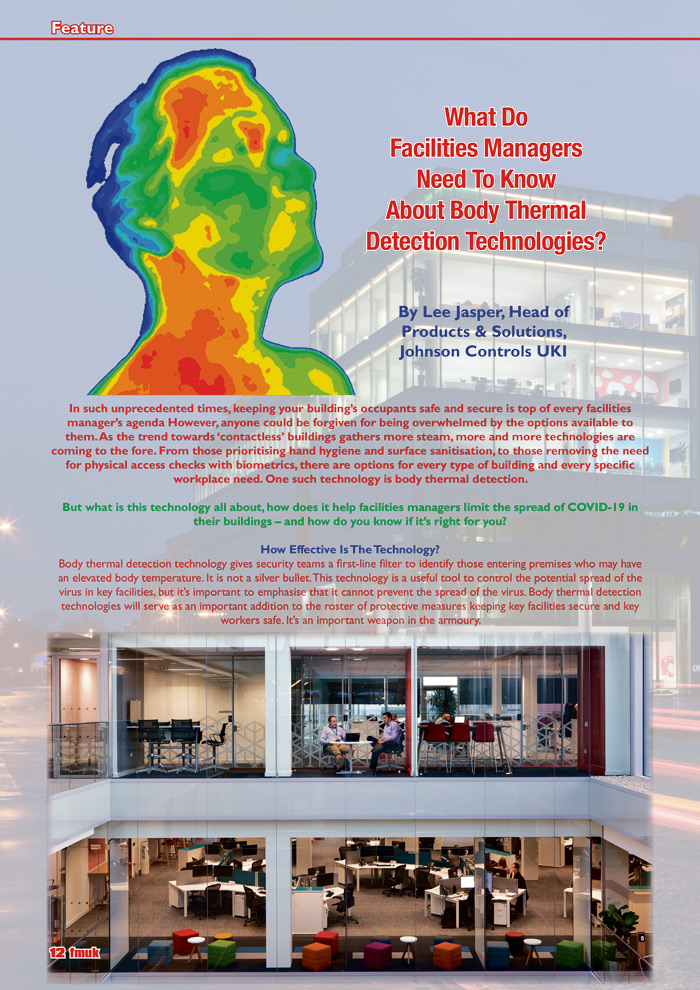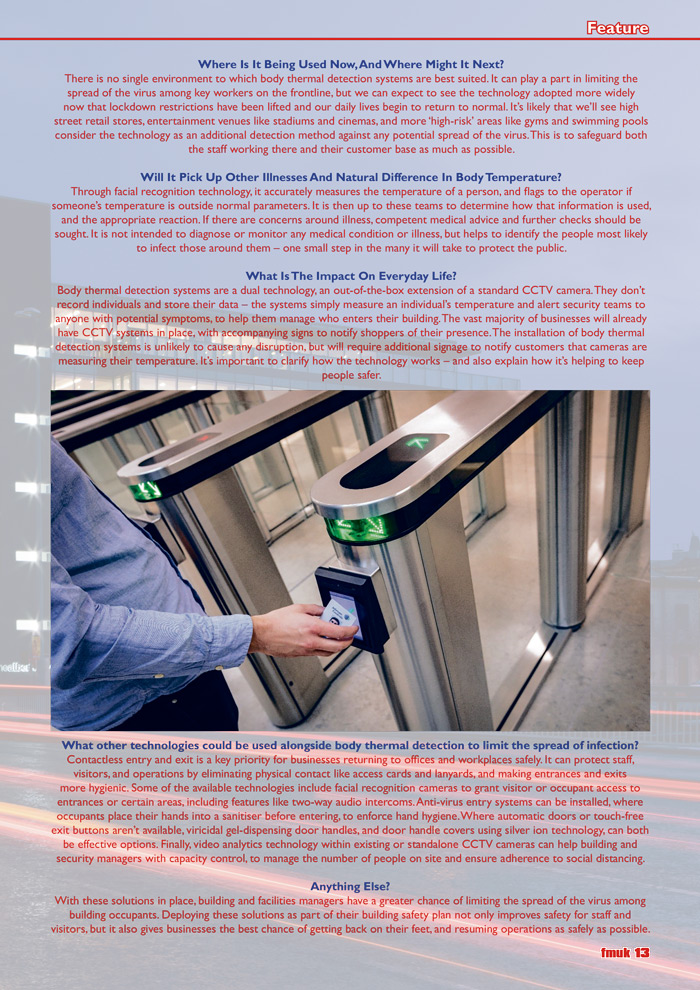What Do Facilities Managers Need To Know About Body Thermal Detection Technologies?
 By Lee Jasper, Head of Products & Solutions, Johnson Controls UKI
By Lee Jasper, Head of Products & Solutions, Johnson Controls UKI
In such unprecedented times, keeping your building’s occupants safe and secure is top of every facilities manager’s agenda. However, anyone could be forgiven for being overwhelmed by the options available to them. As the trend towards ‘contactless’ buildings gathers more steam, more and more technologies are coming to the fore. From those prioritising hand hygiene and surface sanitisation, to those removing the need for physical access checks with biometrics, there are options for every type of building and every specific workplace need.
One such technology is body thermal detection. But what is this technology all about, how does it help facilities managers limit the spread of COVID-19 in their buildings – and how do you know if it’s right for you?
How Effective Is The Technology?
Body thermal detection technology gives security teams a first-line filter to identify those entering premises who may have an elevated body temperature. It is not a silver bullet. This technology is a useful tool to control the potential spread of the virus in key facilities, but it’s important to emphasise that it cannot prevent the spread of the virus. Body thermal detection technologies will serve as an important addition to the roster of protective measures keeping key facilities secure and key workers safe. It’s an important weapon in the armoury.
Where Is It Being Used Now, And Where Might It Next?
There is no single environment to which body thermal detection systems are best suited. It can play a part in limiting the spread of the virus among key workers on the frontline, but we can expect to see the technology adopted more widely now that lockdown restrictions have been lifted and our daily lives begin to return to normal. It’s likely that we’ll see high street retail stores, entertainment venues like stadiums and cinemas, and more ‘high-risk’ areas like gyms and swimming pools consider the technology as an additional detection method against any potential spread of the virus. This is to safeguard both the staff working there and their customer base as much as possible.
Will It Pick Up Other Illnesses And Natural Difference In Body Temperature?
Through facial recognition technology, it accurately measures the temperature of a person, and flags to the operator if someone’s temperature is outside normal parameters. It is then up to these teams to determine how that information is used, and the appropriate reaction. If there are concerns around illness, competent medical advice and further checks should be sought. It is not intended to diagnose or monitor any medical condition or illness, but helps to identify the people most likely to infect those around them – one small step in the many it will take to protect the public.
What Is The Impact On Everyday Life?
Body thermal detection systems are a dual technology, an out-of-the-box extension of a standard CCTV camera. They don’t record individuals and store their data – the systems simply measure an individual’s temperature and alert security teams to anyone with potential symptoms, to help them manage who enters their building. The vast majority of businesses will already have CCTV systems in place, with accompanying signs to notify shoppers of their presence. The installation of body thermal detection systems is unlikely to cause any disruption, but will require additional signage to notify customers that cameras are measuring their temperature. It’s important to clarify how the technology works – and also explain how it’s helping to keep people safer.
What other technologies could be used alongside body thermal detection to limit the spread of infection?
Contactless entry and exit is a key priority for businesses returning to offices and workplaces safely. It can protect staff, visitors, and operations by eliminating physical contact like access cards and lanyards, and making entrances and exits more hygienic. Some of the available technologies include facial recognition cameras to grant visitor or occupant access to entrances or certain areas, including features like two-way audio intercoms. Anti-virus entry systems can be installed, where occupants place their hands into a sanitiser before entering, to enforce hand hygiene. Where automatic doors or touch-free exit buttons aren’t available, viricidal gel-dispensing door handles, and door handle covers using silver ion technology, can both be effective options. Finally, video analytics technology within existing or standalone CCTV cameras can help building and security managers with capacity control, to manage the number of people on site and ensure adherence to social distancing.
Anything Else?
With these solutions in place, building and facilities managers have a greater chance of limiting the spread of the virus among building occupants. Deploying these solutions as part of their building safety plan not only improves safety for staff and visitors, but it also gives businesses the best chance of getting back on their feet, and resuming operations as safely as possible.
























































